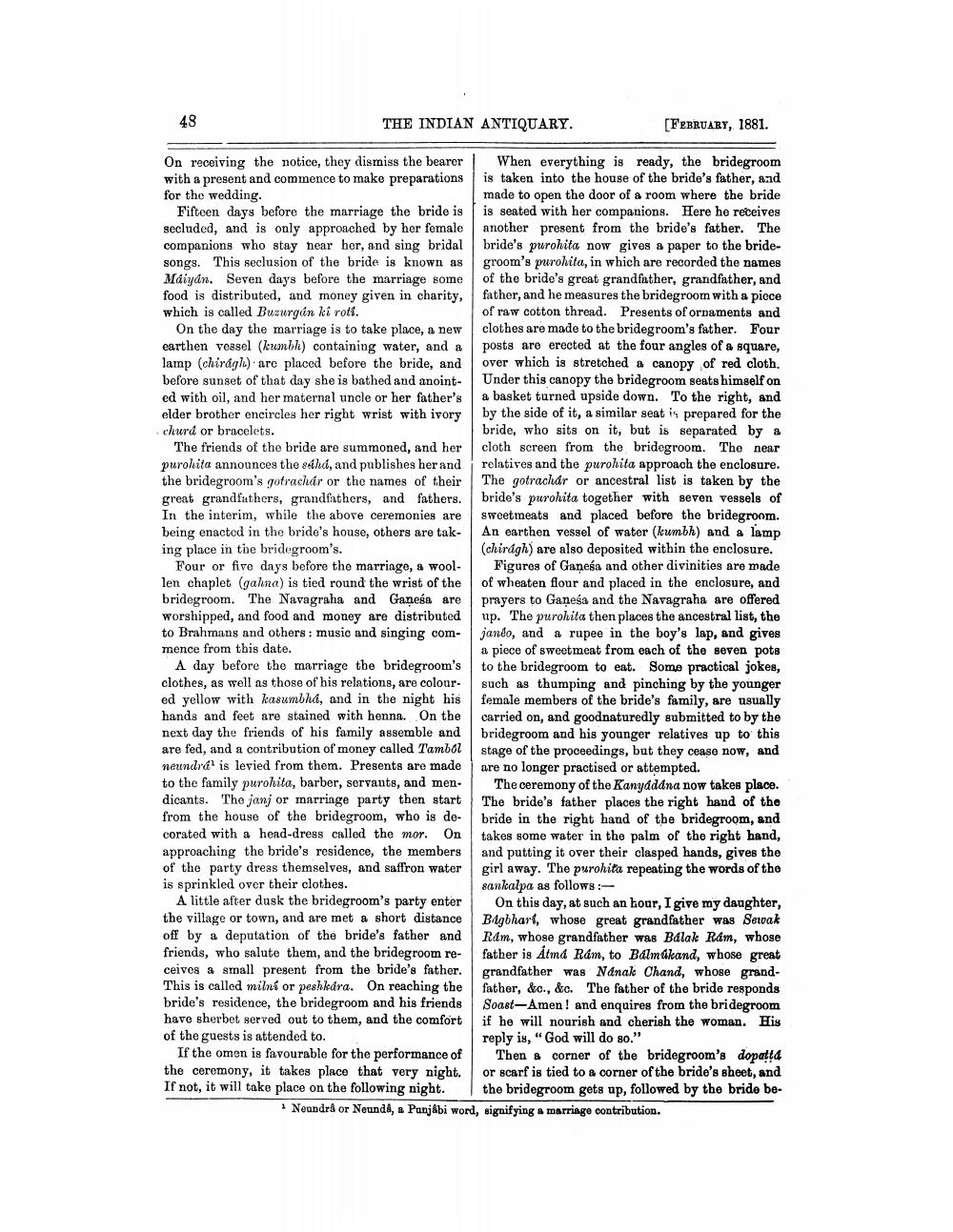________________
48
THE INDIAN ANTIQUARY.
[FEBRUARY, 1881.
On receiving the notice, they dismiss the bearer When everything is ready, the bridegroom with a present and commence to make preparations is taken into the house of the bride's father, and for the wedding.
made to open the door of a room where the bride Fifteen days before the marriage the bride is is seated with her companions. Here he receives secluded, and is only approached by her female another present from the bride's father. The companions who stay near her, and sing bridal | bride's purohita now gives a paper to the bridesongs. This seclusion of the bride is known as groom's purohita, in which are recorded the names Mdiyan. Seven days before the marriage some of the bride's great grandfather, grandfather, and food is distributed, and money given in charity, father, and he measures the bridegroom with a piece which is called Buzurgán ki roti.
of raw cotton thread. Presents of ornaments and On the day the marriage is to take place, a new clothes are made to the bridegroom's father. Four earthen vessel (kumbh) containing water, and a posts are erected at the four angles of a square, lamp (chiragl.) are placed before the bride, and over which is stretched a canopy of red cloth. before sunset of that day she is bathed and anoint- Under this canopy the bridegroom seats himself on ed with oil, and her maternal uncle or her father's a basket turned upside down. To the right, and elder brother encircles her right wrist with ivory by the side of it, a similar seat is prepared for the churd or bracelets.
bride, who sits on it, but is separated by a The friends of the bride are summoned, and her cloth screen from the bridegroom. The near purohita announces the edhd, and publishes her and relatives and the purohita approach the enclosure. the bridegroom's gotrachár or the names of their The gotrachar or ancestral list is taken by the great grandfathers, grandfathers, and fathers. bride's purohita together with seven vessels of In the interim, while the above ceremonies are sweet meats and placed before the bridegroom. being enacted in the bride's house, others are tak- An earthen vessel of water (kumbh) and a lamp ing place in the bridegroom's.
(chirdgh) are also deposited within the enclosure. Four or five days before the marriage, a wool- Figures of Ganesa and other divinities are made len chaplet (galna) is tied round the wrist of the of wheaten flour and placed in the enclosure, and bridegroom. The Navagraha and Ganesa are prayers to Ganesa and the Navagraha are offered worshipped, and food and money are distributed up. The purohita then places the ancestral list, the to Brahmans and others: music and singing com- jando, and a rupee in the boy's lap, and gives mence from this date.
a piece of sweetmeat from each of the seven pots A day before the marriage the bridegroom's to the bridegroom to eat. Some practical jokes, clothes, as well as those of his relations, are colour- such as thumping and pinching by the younger ed yellow with kasumbhd, and in the night his female members of the bride's family, are usually hands and feet are stained with henna. On the carried on, and goodnaturedly submitted to by the next day the friends of his family assemble and bridegroom and his younger relatives up to this are fed, and a contribution of money called Tambol stage of the proceedings, but they cease now, and neundra' is levied from them. Presents are made are no longer practised or attempted. to the family purohita, barber, servants, and men. The ceremony of the Kanyaddna now takes place. dicants. The janj or marriage party then start The bride's father places the right hand of the from the house of the bridegroom, who is de- bride in the right hand of the bridegroom, and corated with a head-dress called the mor. On takes some water in the palm of the right hand, approaching the bride's residence, the members and putting it over their clasped hands, gives the of the party dress themselves, and saffron water girl away. The purohita repeating the words of the is sprinkled over their clothes.
sankalpa as follows:A little after dusk the bridegroom's party enter On this day, at such an hour, I give my daughter, the village or town, and are met a short distance Bigbhart, whose great grandfather was Sewak off by a deputation of the bride's father and Ram, whose grandfather was Balak Ram, whose friends, who salute them, and the bridegroom re- father is Atmd Rám, to Balmúkand, whose great ceives a small present from the bride's father. grandfather was Nanak Chand, whose grandThis is called milní or peshkára. On reaching the father, &c., &c. The father of the bride responds bride's residence, the bridegroom and his friends Soast--Amen! and enquires from the bridegroom havo sherbet served out to them, and the comfort if he will nourish and cherish the woman. His of the guests is attended to.
reply is, "God will do so." If the omen is favourable for the performance of Then a corner of the bridegroom's dopat! the ceremony, it takes place that very night. or scarf is tied to a corner of the bride's sheet, and If not, it will take place on the following night. the bridegroom gets up, followed by the bride be
Noundra or Neund, a Panjabi word, signifying a marriage contribution.




